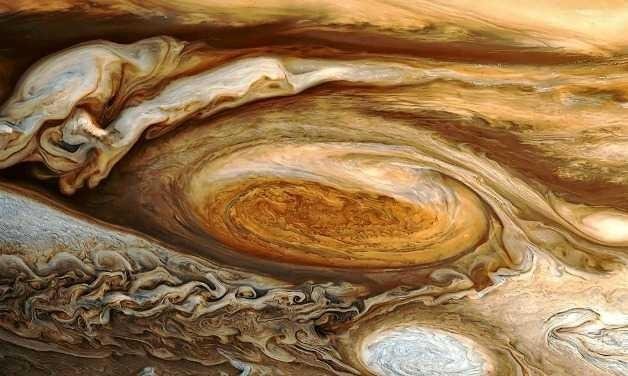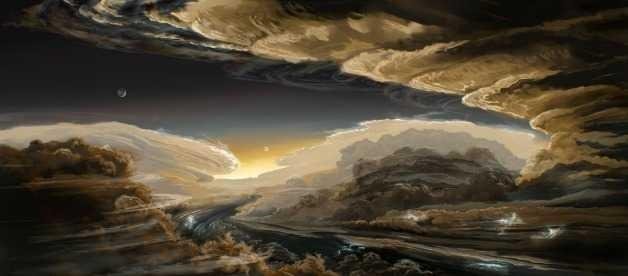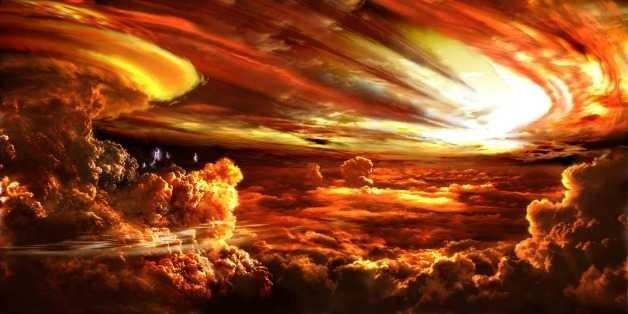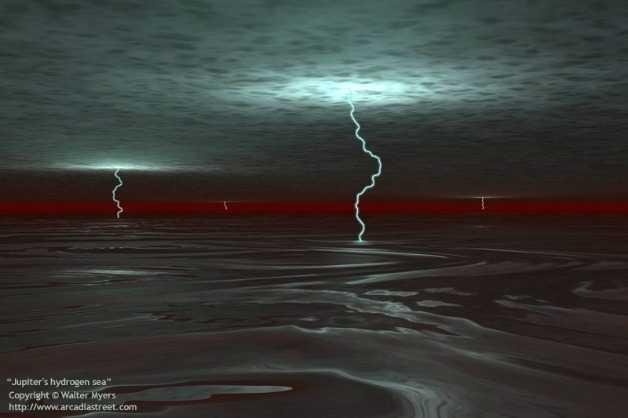A journey to Jupiter
We are about 500,000 kilometers away from Jupiter on board our ship. As we travel in the direction of the atmosphere, the approach maneuver turns out to be much longer than expected: we are sailing at the maximum speed allowed by our propulsion system, yet it seems to us that the planet does not approach one millimeter! This phenomenon occurs because Jupiter is large, so large that the outer layers of its atmosphere begin to occupy our entire field of vision only after several hours of travel, when we are still 300,000 kilometers away from the "surface" of the planet . Now we are no longer able to see the black background of space, all we see are the dense clouds of ammonia and hydrogen that whirl around the equator, forming the characteristic horizontal bands of white, red and brown. As we approach the planet the Great Red Spot slowly begins to transform, so that after a few hours we struggle to distinguish the contours. The huge vortex, which from space seemed to us as a single structure, now appears as a chaotic set of smaller vortices, whose convolutions reveal new and unexpected details on the extreme turbulence of the atmosphere. The mighty columns of gas that emerge from the deepest layers of the planet make Jupiter look like a huge pot filled with boiling water. Arrived at about 150,000 kilometers from the surface, the electromagnetic bombardment caused by the Jupiter magnetosphere is so intense that we are forced to activate the special protections of our spacecraft: if we did not do so we would die for radiation poisoning within a few minutes.

Continuing on our journey we finally reach the edge of the troposphere. The long path of descent to the surface of the gas giant begins here: we disengage from the spacecraft, protected by our space suit, and let gravity drag us towards the core of the planet. Because of its enormous mass Jupiter generates an acceleration of gravity 2.6 times higher than that of the Earth, and if we want to avoid burning like a meteor we have to open a parachute to slow down the fall. At this point our terminal speed goes from 3,200 to 360 kilometers per hour, sufficiently low to avoid any risk of supersonic compression or frictional overheating. Looking around we notice an unusual landscape: the colors vary from bright red to brown and there is a thick layer of mist that prevents us from pushing our gaze further than a few hundred meters. But if we could do it we would see an unparalleled spectacle: the clouds that surround us, up to 45 km high and composed mainly of hydrocarbons, hydrogen, methane and ammonia crystals, would look like huge mountains. We would immediately notice that the ammonia covers the upper surface of the clouds like an oil film on the water, adding a tint of white to the dominant red color.
Pushing our gaze even further, in the direction of the Great Red Spot, we would see an enormous column of turbulent gas rising above the surrounding clouds, almost as if it were floating above the troposphere. This phenomenon of stratification of clouds is caused by the rapid spin of the planet, which rotates on itself in less than 10 hours, and by the atypical density of the atmosphere, similar in consistency to an oily substance. Where we are now the conditions of pressure and temperature are similar to those of the Earth, but the winds that rage around the spacecraft are dragging us at a speed of over 560 kilometers per hour and the intensity of the radiation generated by the Jovian magnetic field could still kill us in a few minutes, in the absence of protections. The noise generated by the turbulence is deafening, because here the speed of sound is four times higher than what we are used to. From time to time the sky is crossed by violent lightning tens of kilometers long, thousands of times more powerful than those on Earth. Lightning strikes are mainly caused by rains of water, sulfuric acid and ammonia, which due to the gravitational attraction of Jupiter fall at a rate three times higher than that of the Earth's rains, creating a huge potential difference. After just 5 minutes the atmospheric pressure rises to 2 bar (twice that of the earth) and we begin to cross a new layer of clouds, this time composed of ammonium sulphite and ammonium hydrosulfide. The conditions of the environment in which we are immersed are rather extreme, but at this moment we do not need any additional protection other than a good radiation shielding. Although the weight of the overhead air begins to grow following an exponential curve, the relatively low fall velocity allows the cavities of our body to equalize their internal pressure without generating undesirable effects.

Spend another 10 minutes and the pressure reaches 4 bar (corresponding to what we would experience on the Earth immersing in water at a depth of 30 meters) while the temperature drops to -40 degrees Celsius. Now we are crossing icy water clouds and the ambient brightness continues to decrease. The speed of the winds rises to 720 kilometers per hour but we hardly notice it, because the level of turbulence of the atmosphere decreases progressively. Another 15 minutes of fall and the pressure rises to 10 bar. At this point, to avoid harmful effects on the body we must change the air mixture provided by the respirator of the suit: if we did not do it in a few minutes we would go to oxygen poisoning, or to a narcotic narcosis, because under pressure the two gases become toxic. Let's take a last look above us, just in time to see the faint disk of the Sun disappearing in the orange fog.

Another 25 minutes pass and the situation begins to get complicated. The special protective suit we are equipped with must withstand a temperature above 100 degrees Celsius, in continuous and constant increase, accompanied by an atmospheric pressure sufficient to curl a car. We find ourselves suddenly immersed in the darkness and we can no longer distinguish anything. The absence of light is due to the density and chemical composition of the air: around us now there are only hydrogen, helium, ammonium sulphide and traces of water vapor, compressed to such an extent as to absorb all the electromagnetic radiation coming from the Sun. Our journey has turned into a slow fall in the darkness. As we continue in the descent, temperature and atmospheric pressure increase exponentially. We continue to slow down because of the increasing atmospheric density, while around us it is raining molten iron. The gases are compressed more and more, starting to behave like liquids. If we had to abandon our special protective suit we would be crushed and vaporized in a fraction of a second.
Now we are not even able to establish where we are in relation to the nucleus of Jupiter, because the transition between gas and liquid is so gradual that we fail to realize the change in density. Below us, at an unspecified distance, we notice a faint luminescence caused by the energy that radiates from the nucleus of the planet. The atmosphere is now almost completely made of liquid hydrogen that boils at thousands of degrees centigrade, as on the surface of the Sun. The pressure rises rapidly from 1,000 to 2,000,000 bar and the atmospheric density exceeds that of water, rising to 1000 kilograms per cubic centimeter. At this point the fall stops because our body, being less dense than the matter that surrounds it, can no longer sink once the kinetic energy of the fall has been exhausted.

To continue we need a thrust, then we turn on the engines of our suit and try to go into the bowels of Jupiter, deeper and deeper. From here onwards, for several hours, the journey turns out to be particularly boring because they dominate the darkness and the silence, and continue becoming more and more difficult. But after a time that seems interminable, something unexpected happens: the darkness is torn by a network of lightning that vaguely resembles a spider's web. We are sailing in a vast ocean of metallic liquid hydrogen, an exotic substance that behaves like a superconductor and is primarily responsible for the intense magnetic field we had encountered at the beginning of the journey. Under normal pressure and temperature, hydrogen is a gas, but if its density exceeds a critical point it turns into something different, a substance that flows like a viscous liquid and conducts electricity like a metal. The lightning we had seen in the troposphere is nothing compared to those that cross this boundless ocean, whose surface is ten times larger than that of the Earth. Where we are now, pressure and temperature have reached such high levels that they escape any attempt at understanding.
No matter how hard we try, we can not go any further. Below us is now the nucleus of Jupiter: astronomers believe that it is mostly solid and that it contains most of the elements of greatest weight of the planet, such as ice, rock, iron and other heavy components, with a considerable amount of hydrogen. To be able to walk on its surface we should be able to survive pressures 4,000,000 times higher than that of the Earth's surface and at temperatures of over 35,000 degrees Celsius. Too much even for our imagination!
Fantastica l'astronomia. Io ho un piccolo telescopio e guardare questi pianeti da migliaia e migliaia di km di distanza è sempre incredibile!
Stupendo! Potessi averlo anch'io un telescopio di modeste dimensioni :D